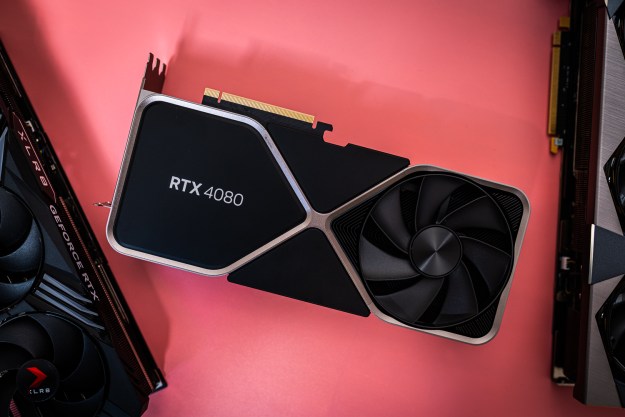In almost every industry, competition drives innovation up and prices down, and in PC hardware, there’s little as hotly competitive as the graphics card market. But what’s good for the gamer is good for the gander too, because while AMD may be riding high on a wave of publicity, goodwill, and mindshare after the release of its FidelityFX Super Resolution upscaling algorithm, Nvidia is more than happy to coast atop it. It’s been trying for a long time to make upscaling relevant, and in releasing a solution that’s available to almost everyone, AMD has done it instead.
Nvidia could benefit from that tremendously.
FSR’s strength could be DLSS’ too
When FidelityFX Super Resolution was first shown off by AMD, I said that even if it turned out to be a fraction as good as AMD claimed, it would be an absolute game-changer. When we got our hands on the technology, it proved to be even better than we hoped, offering gamers a big boost in performance with minimal image degradation, even at the highest quality settings.
But the real strength of FSR is that almost anyone can use it. Whether you’re running a cutting-edge 4K GPU or an entry-level card from five years ago. It works on Nvidia cards too, and there are even some claims of it working on Intel GPUs. Consoles could follow, giving FSR an immediate and enormous potential player base.

That’s very different from Nvidia’s DLSS strategy. As much as its own supporting cards have grown more popular over the past three years, RTX 2000 and 3000 cards are still very much in the minority. Nvidia’s own GTX 10 series and 16-series cards dominate the Steam Hardware Survey, and though Nvidia has been magnanimous enough to give them the ability to stutteringly try ray tracing, it’s kept DLSS firmly locked behind a paywall that in 2021 has grown to truly ridiculous heights.
Which is why Nvidia must be thanking its lucky stars that AMD launched FSR to such great success. It now has a fight on its hands in convincing gamers that not only is DLSS better than FSR, but that it’s worth buying a new graphics card for.
That’s a fight that it wants to have, because it believes it can win.
Thanks to FSR, gamers can now get a taste of what upscaling technology can do, especially at the low end of the market which Nvidia has stubbornly refused to cater to (at least for now). But when GPU prices finally stabilize and we can all afford to buy graphics cards again, those gamers looking to upgrade will far better understand the potential of DLSS and may just opt to pay for its privilege.
Nvidia Ultra Quality – More than just a name
Following the release of FSR, and its subsequent near-universal praise, Nvidia has been quick with a retort of its own, pushing the story that DLSS is available on more and bigger games, like Fortnite, Minecraft, and Doom Eternal.

It’s also stressed the overall greater image quality of DLSS, which is a claim few would have argued with. But it may improve it further still, with rumors of a new Ultra Quality mode set to launch soon. Discovered during a recent release of the Unreal Engine 5 documentation, this preset seems likely to use a greater input resolution than the existing Quality preset, potentially leading to an image quality that is closer to native, without quite the same performance benefits as the lower settings.
It seems awfully convenient that this is coming about shortly after the release of FSR, though, which has its own Ultra Quality setting. Whether it’s because the image quality of FSR surprised Nvidia and feels the need to improve its own, or it merely doesn’t like FSR having a mode that sounds like it’s better than its existing DLSS Quality mode, will likely remain a mystery.

But there’s no denying that DLSS is a smarter and more in-depth upscaling process. Its use of motion vectors gives it a real advantage over FSR, and though Nvidia’s technique does have its own unique visual artifacts to deal with, they aren’t the kind of heavy-handed sharpening that FSR users experience on most of the settings outside Ultra Quality.
You could certainly make the argument that DLSS is the premium upscaler available today. The problem still remains, however, that it’s very much a premium feature, for gamers who can afford to pay for it.
It’s no good if few people can use it
DLSS is great. It’s effective, looks good, offers great performance advantages, and it’s getting better all the time. But – and I know Nvidia feels I’m wrong on this one – it’s still barely available to anyone. Yes, the RTX 2060 is a popular card, but the overall RTX 2000 and 3000 series barely encapsulates 15% of all Steam gamers.

If AMD had made FSR available to only its own GPUs, it would be in a similar state. But it didn’t, and it isn’t. FSR works on everything, even cards it wasn’t designed to benefit, like Nvidia’s 900-series Maxwell GPUs. DLSS works on the latest and the greatest, which is great for the greatest of gamers with the grandest of wallets, but it’s largely useless for anyone else.
FSR, though, isn’t. Whether you use it or not, whether Nvidia will optimize for it or not, FSR is good for DLSS, and it’s good for Nvidia. FSR is going to put upscaling on the map and Nvidia knows all too well that it has the potential to lead people right to its new-generation GPUs. If Nvidia wants DLSS to remain relevant, it may well need it to.
Nvidia told Digital Trends that we can expect tensor cores in all GeForce GPUs moving forward, and that if we look at recent developments on the laptop front, we can expect something similar on desktop before long. That means more affordable RTX 3050 and 3050 Ti GPUs are likely going to hit desktop in the not-too-distant future.
That’s great. It’s exactly what DLSS needs to help those it has the most potential to benefit. Nvidia will no doubt keep tensor core counts low, and retain the biggest performance benefits for its premium customers, but it’s a start. It doesn’t seem likely that Nvidia will repeat its 16-series generational mistakes of keeping its entry-level consumers firmly locked in the past.
The upscaler wars are here, but should you care?
Not at all. This is one of those wonderful cases where the actions of both AMD and Nvidia are going to benefit almost every gamer. FSR is forcing Nvidia’s hand to make DLSS more inclusive and of higher quality. That in turn will keep AMD hunting for the perfect upscaler, with FSR offering a good-enough solution that looks set to redefine what upscaling is for most gamers.
If I had to put money on which will be more popular long term, I’d say FSR, thanks to its likely use on consoles, its more open standard approach, and its relative simplicity. But I don’t think DLSS is going the way of HairWorks any time soon. If all goes to plan, future Nvidia fans will be able to enable DLSS in the games they want, giving them a great quality and performance boost. For everything else, FSR will be there, giving every gamer those much-needed extra frames per second they’re always chasing.
Editors' Recommendations
- AMD finally has a strategy to beat Nvidia’s DLSS
- Here’s how AMD counters Nvidia’s big RTX Super launch
- Nvidia may launch three new Super GPUs to fight back AMD
- Nvidia’s DLSS 3.5 update flips ray tracing on its head
- Here’s why people are so upset about today’s Starfield PC news





